Jack Holmes
Fri, October 1, 2021, 11:58 AM·3 min read

Photo credit: screenshot - Twitter
We've got a new offering from the Department of On-the-Nose Metaphors courtesy of Joe Manchin, his yacht, and some activists on kayaks. There's been a sense throughout the extended infrastructure saga that key players therein are beyond the reach of their constituents and the public, striding the marble halls of the Capitol fielding the occasional question about the reconciliation bill's price tag or intra-Democratic Party squabbling. Rarely is the West Virginia senator—or Arizona's Kyrsten Sinema, for that matter—asked why he is blocking the most significant investment in everyday American families in generations, or why he opposes a critical framework to begin decarbonizing our transportation and energy systems in earnest. There is seldom much discussion of what's actually in the $3.5 trillion bill, a list that includes changes to the tax code that would ensure the bill does not actually cost $3.5 trillion. There is almost never any mention of the fact that we spend vastly more on bombs and bullets and planes that don't work every year without even a moment's hesitation over inflation or The National Debt. Made-up nonsense like the filibuster or the reconciliation process itself are taken for granted.
Sometimes, it just takes some activists in kayaks, I guess. They floated up to Manchin's sprawling yacht in Washington, D.C. on Thursday and asked some questions that need to be asked, creating a visual in the process that speaks just as loudly. Here's one of 100 senators, imbued with superpowers thanks to the quirks of our constitutional system, leaning over the ramparts to speak to the common folk below as they ask, with no little desperation, why we can't fund dental coverage as part of Medicare.
Manchin still seems to be sticking to this idea that the bill is just too big and it makes him uncomfortable. This at least points towards the notion that there is some size of bill that he would support. His compatriot in this mission to torpedo the domestic agenda of a president in his own nominal party, Kyrsten Sinema, can scarcely assure us of even that much. Sinema has donors to feed, but her strategy to avoid passing a set of vital and popular proposals is increasingly chaotic and inscrutable.
The Arizona senator has reportedly left Washington on Friday as the machinations over the two bills—reconciliation and the parallel Bipartisan Infrastructure Framework—continue apace. There appeared a completely disorienting missive in Axios in which anonymous "allies" of "the wine-drinking triathlete" talked up her imperviousness to political pressure. (The article obsesses over the wine thing throughout.) Sinema is apparently opposed to raising taxes on corporations and the rich too much, but she's also concerned about The National Debt, but she also took a central role crafting the separate bipartisan bill which is "paid for" through accounting witchcraft. Also, nobody cares about The National Debt. They just don't want to pay taxes to fund social programs.
Sinema's poll numbers are taking a turn, but that doesn't seem to be affecting her calculus. And meanwhile, through these weeks and weeks of drag-on legislating, the West was on fire and seemingly everywhere else in this country was under threat of drowning. The boosted pandemic unemployment benefits are gone, and more and more people will be going to work sick. None of this seems to matter? Just a completely bewildering time to be alive.
Sinema's poll numbers are taking a turn, but that doesn't seem to be affecting her calculus. And meanwhile, through these weeks and weeks of drag-on legislating, the West was on fire and seemingly everywhere else in this country was under threat of drowning. The boosted pandemic unemployment benefits are gone, and more and more people will be going to work sick. None of this seems to matter? Just a completely bewildering time to be alive.
HIS BASE
Manchin winning cautious applause from GOP voters in West Virginia
David M. Drucker
Manchin winning cautious applause from GOP voters in West Virginia
David M. Drucker
WASHINGTON EXAMINER
Sat, October 2, 2021

Republicans in West Virginia are pleasantly surprised as they watch Sen. Joe Manchin almost single-handedly derail Democratic plans to pass $3.5 trillion in fresh domestic spending.
The Democratic former governor has made a Washington career out of threatening to block massive spending bills and other liberal legislation, only to fall in the line with party leadership and left-wing colleagues. West Virginia Republicans even have a nickname for Manchin based on this pattern of political maneuvering since his election to the Senate in 2010: “Yes-no Joe.” But something is different about Manchin’s opposition to the size and scope of the $3.5 trillion bill.
This time around, Manchin appears dug-in and unflappable in the face of pressure from President Joe Biden and liberal Democrats in the House and Senate. Republicans back home in West Virginia cannot help but notice, even if begrudgingly.
“Are we glad that he is opposed to the ultra-liberal, crazy Green New Deal? Yes," said John Findlay, the executive director of the West Virginia Republican Party. “We’re hopeful that it lasts.”
Manchin, 74, during his tenure on Capitol Hill, has cultivated the image of a centrist. Yet, his votes on the Senate floor tell a different story. Manchin’s lifetime score on legislation with the conservative Club for Growth is a paltry 21%. And under former President Barack Obama, the conservative group Heritage Action for America awarded the senator an average score on legislation of just 13% — meaning he was a reliable vote for the administration.
But under Biden and in the face of ambitious liberal proposals from Democrats in the House and Senate, Manchin has been a fly in the ointment of key elements of his party’s fiscal and social agenda. In a Senate that is evenly split between the parties and controlled by the Democrats only because of Vice President Kamala Harris’s tiebreaking vote, Manchin is singularly empowered to obstruct legislation such as the $3.5 trillion reconciliation package.
And Manchin is doing so, just as he signaled he would to Senate Majority Leader Chuck Schumer of New York months ago.
The senator said then, and reiterated this week, that he favors a reconciliation package that spends no more than $1.5 trillion. Manchin opposes a provision of the bill that would raise corporate taxes above his preferred threshold — and he is demanding that the legislation include the Hyde Amendment, which prohibits federal funds from being used to finance abortions. Reconciliation packages are filibuster-proof and require a simple majority to pass. Without Manchin, Democrats are stuck.
“While I am hopeful that common ground can be found that would result in another historic investment in our nation, I cannot — and will not — support trillions in spending or an all or nothing approach that ignores the brutal fiscal reality our nation faces,” Manchin said in a statement. He also has ruffled Democratic feathers by refusing to vote to junk the 60-vote “filibuster” threshold for legislation.
Manchin has company. Sen. Kyrsten Sinema of Arizona is opposing the reconciliation package in its current form, citing problems with the legislation similar to those voiced by her fellow Democrat from West Virginia (a few additional Senate Democrats are silently cheering Manchin and Sinema on). Both have sparked the ire of Democratic activists — in Washington and back home. However, their opposition makes for great general election politics, including in swing-state Arizona and deep-red West Virginia.
But between them, it is Manchin who is doing all of the talking. In West Virginia, some Republicans are cynical about the senator’s intentions. In a state former President Donald Trump in 2020 won with 68.6% of the vote, Manchin has no choice but to make a big deal about his apprehension to go along with his party’s liberal agenda, they say, especially if he wants to run for reelection in 2024.
In fact, some Republican insiders are convinced Manchin is simply preserving his political viability. Democrats, once dominant in the state, are now firmly ensconced in the minority. But Republican operatives also concede that Manchin is impressing his conservative constituents, even if they are girding for the possibility that he will cave in the end.
“Conservative voters in West Virginia, whether they are Democrats, independents, or Republicans, will view any effort to control government spending favorably,” said Mark Blankenship, a GOP strategist who is based in the state.
Sat, October 2, 2021

Republicans in West Virginia are pleasantly surprised as they watch Sen. Joe Manchin almost single-handedly derail Democratic plans to pass $3.5 trillion in fresh domestic spending.
The Democratic former governor has made a Washington career out of threatening to block massive spending bills and other liberal legislation, only to fall in the line with party leadership and left-wing colleagues. West Virginia Republicans even have a nickname for Manchin based on this pattern of political maneuvering since his election to the Senate in 2010: “Yes-no Joe.” But something is different about Manchin’s opposition to the size and scope of the $3.5 trillion bill.
This time around, Manchin appears dug-in and unflappable in the face of pressure from President Joe Biden and liberal Democrats in the House and Senate. Republicans back home in West Virginia cannot help but notice, even if begrudgingly.
“Are we glad that he is opposed to the ultra-liberal, crazy Green New Deal? Yes," said John Findlay, the executive director of the West Virginia Republican Party. “We’re hopeful that it lasts.”
Manchin, 74, during his tenure on Capitol Hill, has cultivated the image of a centrist. Yet, his votes on the Senate floor tell a different story. Manchin’s lifetime score on legislation with the conservative Club for Growth is a paltry 21%. And under former President Barack Obama, the conservative group Heritage Action for America awarded the senator an average score on legislation of just 13% — meaning he was a reliable vote for the administration.
But under Biden and in the face of ambitious liberal proposals from Democrats in the House and Senate, Manchin has been a fly in the ointment of key elements of his party’s fiscal and social agenda. In a Senate that is evenly split between the parties and controlled by the Democrats only because of Vice President Kamala Harris’s tiebreaking vote, Manchin is singularly empowered to obstruct legislation such as the $3.5 trillion reconciliation package.
And Manchin is doing so, just as he signaled he would to Senate Majority Leader Chuck Schumer of New York months ago.
The senator said then, and reiterated this week, that he favors a reconciliation package that spends no more than $1.5 trillion. Manchin opposes a provision of the bill that would raise corporate taxes above his preferred threshold — and he is demanding that the legislation include the Hyde Amendment, which prohibits federal funds from being used to finance abortions. Reconciliation packages are filibuster-proof and require a simple majority to pass. Without Manchin, Democrats are stuck.
“While I am hopeful that common ground can be found that would result in another historic investment in our nation, I cannot — and will not — support trillions in spending or an all or nothing approach that ignores the brutal fiscal reality our nation faces,” Manchin said in a statement. He also has ruffled Democratic feathers by refusing to vote to junk the 60-vote “filibuster” threshold for legislation.
Manchin has company. Sen. Kyrsten Sinema of Arizona is opposing the reconciliation package in its current form, citing problems with the legislation similar to those voiced by her fellow Democrat from West Virginia (a few additional Senate Democrats are silently cheering Manchin and Sinema on). Both have sparked the ire of Democratic activists — in Washington and back home. However, their opposition makes for great general election politics, including in swing-state Arizona and deep-red West Virginia.
But between them, it is Manchin who is doing all of the talking. In West Virginia, some Republicans are cynical about the senator’s intentions. In a state former President Donald Trump in 2020 won with 68.6% of the vote, Manchin has no choice but to make a big deal about his apprehension to go along with his party’s liberal agenda, they say, especially if he wants to run for reelection in 2024.
In fact, some Republican insiders are convinced Manchin is simply preserving his political viability. Democrats, once dominant in the state, are now firmly ensconced in the minority. But Republican operatives also concede that Manchin is impressing his conservative constituents, even if they are girding for the possibility that he will cave in the end.
“Conservative voters in West Virginia, whether they are Democrats, independents, or Republicans, will view any effort to control government spending favorably,” said Mark Blankenship, a GOP strategist who is based in the state.
Joe Manchin said in January he'd be okay with $4 trillion in infrastructure, but now he wants a lot less. Here's a full timeline of his price tags.
Juliana Kaplan,Ben Winck
Sat, October 2, 2021

Senator Joe Manchin, a West Virginia Democrat, talks on the phone during a Senate Appropriations Subcommittee hearing on June 9, 2021 at the U.S. Capitol in Washington, D.C. The committee is hearing testimony about the Fiscal Year 2022 budget request for the Department of Health and Human Services.
Now, it's progressives versus moderates
For months, progressives have warned they'll torpedo any attempt to bring the $1.2 trillion bipartisan infrastructure package without the $3.5 trillion party-line reconciliation moving in tandem. House Speaker Nancy Pelosi has attempted to do just that, a risky gamble as there is no guarantee the reconciliation bill would pass afterward.
After the progressive wing of the party pushed back, a Thursday vote on the bipartisan package was pulled as Democrats regrouped and confusion reigns about what comes next.
"We started off with the $10 trillion number. They wanted to bring that down to six, so we obliged, negotiating in good faith. Then several months ago, we had an agreement with Senator Manchin … saying we will move forward on this $3.5 trillion," Rep. Alexandria Ocasio-Cortez told NBC's Garrett Haake. "Since then, some folks in our party have reneged on that agreement, and that's where I think we have an issue of trust."
What is clear, though, is Manchin's opinion will continue to dictate where the package goes next. And a statement on Wednesday at least signaled where his head is at: "Spending trillions more on new and expanded government programs, when we can't even pay for the essential social programs, like Social Security and Medicare, is the definition of fiscal insanity."
Juliana Kaplan,Ben Winck
Sat, October 2, 2021

Senator Joe Manchin, a West Virginia Democrat, talks on the phone during a Senate Appropriations Subcommittee hearing on June 9, 2021 at the U.S. Capitol in Washington, D.C. The committee is hearing testimony about the Fiscal Year 2022 budget request for the Department of Health and Human Services.
Photo by Al Drago-Pool/Getty
Sen. Joe Manchin is once again pivotal to Democrats' legislative plans. And he's been far from consistent.
A recently published memo showed Manchin only backs a $1.5 trillion reconciliation package. He supported a $4 trillion plan in January.
Here's a timeline of Manchin's spending limits - and how they've both aided and obstructed Biden's agenda.
If you can't keep track of Democrats' massive spending push, you aren't alone. Even the party's most impactful senator has changed course multiple times in the past year.
West Virginia Sen. Joe Manchin is a pivotal figure in the passage of any Democratic legislation right now. The party holds on to a razor-thin margin, and losing the moderate Democrat's support would doom much of President Joe Biden's legislative agenda.
The party entered the last week of September with several policy battles to win. Among the most important is Biden's $3.5 trillion spending plan, which would be the country's biggest expansion of social programs since the New Deal of the 1930s. It comes in addition to a $1 trillion bill for roads and bridges that passed the Senate in a bipartisan vote.
As negotiations have dragged on, Manchin has emerged as a clear opponent of the larger plan, and thanks to him and fellow moderate Sen. Kyrsten Sinema, of Arizona, the $3.5 trillion proposal is all but dead. Manchin is now pushing a package that's less than half the proposed size. In January, he sang a different tune.
In 9 months, Manchin shrunk his price tag by over $1 trillion
In July, Manchin presented his infrastructure proposals to Senate Majority Leader Chuck Schumer, Politico revealed and Insider confirmed. His $1.5 trillion topline is far lower than the reconciliation package around which Democrats have coalesced.
Manchin reaffirmed his commitment to $1.5 trillion on Thursday, telling reporters that "I believe in my heart" that's the most that the country can afford right now.
In January, Manchin said he'd back up to $4 trillion in infrastructure spending, as then-president-elect Joe Biden laid out his plans for office.
"The most important thing? Do infrastructure. Spend $2, $3, $4 trillion over a 10-year period on infrastructure," Manchin told Inside West Virginia Politics in January.
He reaffirmed his support for a larger package in April, as Senate Republicans readied their own much smaller infrastructure package.
"We're going to do whatever it takes. If it takes $4 trillion, I'd do $4 trillion, but we have to pay for it," Manchin told reporters at the time, saying that he would go big if the situation warranted it.
The document obtained by Politico is dated July 28, meaning that it came about two weeks after Senate Democrats announced their $3.5 trillion reconciliation deal. Ahead of that deal, Manchin said any Democratic-only plan would need to be fully paid for, and not require borrowing money.
After Manchin presented his proposals to Schumer, all 50 Senate Democrats voted to advance the $3.5 trillion blueprint and send it to the House. That unanimous support is now on the ropes.
Sen. Joe Manchin is once again pivotal to Democrats' legislative plans. And he's been far from consistent.
A recently published memo showed Manchin only backs a $1.5 trillion reconciliation package. He supported a $4 trillion plan in January.
Here's a timeline of Manchin's spending limits - and how they've both aided and obstructed Biden's agenda.
If you can't keep track of Democrats' massive spending push, you aren't alone. Even the party's most impactful senator has changed course multiple times in the past year.
West Virginia Sen. Joe Manchin is a pivotal figure in the passage of any Democratic legislation right now. The party holds on to a razor-thin margin, and losing the moderate Democrat's support would doom much of President Joe Biden's legislative agenda.
The party entered the last week of September with several policy battles to win. Among the most important is Biden's $3.5 trillion spending plan, which would be the country's biggest expansion of social programs since the New Deal of the 1930s. It comes in addition to a $1 trillion bill for roads and bridges that passed the Senate in a bipartisan vote.
As negotiations have dragged on, Manchin has emerged as a clear opponent of the larger plan, and thanks to him and fellow moderate Sen. Kyrsten Sinema, of Arizona, the $3.5 trillion proposal is all but dead. Manchin is now pushing a package that's less than half the proposed size. In January, he sang a different tune.
In 9 months, Manchin shrunk his price tag by over $1 trillion
In July, Manchin presented his infrastructure proposals to Senate Majority Leader Chuck Schumer, Politico revealed and Insider confirmed. His $1.5 trillion topline is far lower than the reconciliation package around which Democrats have coalesced.
Manchin reaffirmed his commitment to $1.5 trillion on Thursday, telling reporters that "I believe in my heart" that's the most that the country can afford right now.
In January, Manchin said he'd back up to $4 trillion in infrastructure spending, as then-president-elect Joe Biden laid out his plans for office.
"The most important thing? Do infrastructure. Spend $2, $3, $4 trillion over a 10-year period on infrastructure," Manchin told Inside West Virginia Politics in January.
He reaffirmed his support for a larger package in April, as Senate Republicans readied their own much smaller infrastructure package.
"We're going to do whatever it takes. If it takes $4 trillion, I'd do $4 trillion, but we have to pay for it," Manchin told reporters at the time, saying that he would go big if the situation warranted it.
The document obtained by Politico is dated July 28, meaning that it came about two weeks after Senate Democrats announced their $3.5 trillion reconciliation deal. Ahead of that deal, Manchin said any Democratic-only plan would need to be fully paid for, and not require borrowing money.
After Manchin presented his proposals to Schumer, all 50 Senate Democrats voted to advance the $3.5 trillion blueprint and send it to the House. That unanimous support is now on the ropes.
Now, it's progressives versus moderates
For months, progressives have warned they'll torpedo any attempt to bring the $1.2 trillion bipartisan infrastructure package without the $3.5 trillion party-line reconciliation moving in tandem. House Speaker Nancy Pelosi has attempted to do just that, a risky gamble as there is no guarantee the reconciliation bill would pass afterward.
After the progressive wing of the party pushed back, a Thursday vote on the bipartisan package was pulled as Democrats regrouped and confusion reigns about what comes next.
"We started off with the $10 trillion number. They wanted to bring that down to six, so we obliged, negotiating in good faith. Then several months ago, we had an agreement with Senator Manchin … saying we will move forward on this $3.5 trillion," Rep. Alexandria Ocasio-Cortez told NBC's Garrett Haake. "Since then, some folks in our party have reneged on that agreement, and that's where I think we have an issue of trust."
What is clear, though, is Manchin's opinion will continue to dictate where the package goes next. And a statement on Wednesday at least signaled where his head is at: "Spending trillions more on new and expanded government programs, when we can't even pay for the essential social programs, like Social Security and Medicare, is the definition of fiscal insanity."
WV EXPORTS NAT GAS NOT COAL
Joe Manchin Just Cooked the PlanetJeff Goodell
Fri, October 1, 2021,

Joe Manchin - Credit: AP Photo/J. Scott Applewhite
West Virginia Sen. Joe Manchin just cooked the planet. I don’t mean that in a metaphorical sense. I mean that literally. Unless Manchin changes his negotiating position dramatically in the near future, he will be remembered as the man who, when the moment of decision came, chose to condemn virtually every living creature on Earth to a hellish future of suffering, hardship, and death.
Quite a legacy. But he has earned it.
Last night, during the insane and at times comical negotiations over President Biden’s infrastructure bill and his $3.5 trillion Build Back Better agenda (aka the reconciliation bill), Manchin let it be known that he was not going to vote for any measure above $1.5 trillion. And because Democrats can’t afford to lose a single vote in the Senate, if Manchin won’t vote for it, the reconciliation bill won’t pass.
The $3.5 trillion reconciliation bill includes a long list of programs and tax reforms that will help reduce poverty and improve the social safety net, such as universal child tax credit, universal pre-K, free community college, and an expansion of Medicare. But it is also the primary vehicle for President Biden’s ambitious climate action agenda, including cuts in subsidies for the fossil fuel industry, and, most importantly, the Clean Energy Performance Package (CEPP), which is a clean energy standard that incentivizes power companies to shift away from fossil fuels.
From a climate point of view, the importance of these climate policy measures is impossible to overstate. In order to have a decent chance at maintaining a habitable planet, scientists agree that the world needs to zero out carbon pollution by 2050. And to have any shot at that, we have to start moving now. Every year, every month, every hour of delay makes that goal more difficult to achieve, and increases the risks of accelerated climate chaos that will make this past summer of hellish wildfires, storms, and droughts look like the good old days.
The zero carbon by 2050 goal is not a political slogan or environmentalist’s dream. It is what the best scientists in the world are telling us we need to do to avert climate catastrophe. It is also the basis for Biden’s goal of a 100 percent clean energy grid by 2035, and a 50 percent reduction in CO2 pollution by 2030. For Biden, taking strong action on climate is not just important in itself. It is also key to giving the U.S. climate negotiators something to bring to the table at the upcoming Glasgow climate talks, which begin on October 31st. After President Trump pulled the U.S. out of the Paris climate deal, the rest of the world has looked at the U.S. with distrust. Passage of strong climate measures in Congress before the Glasgow meeting would not only rehabilitate America’s standing as a nation that takes its contribution to solving the climate crisis seriously, but give U.S. negotiators leverage to push other nations to take action.
For Biden, and for the world, it all rests on the ability to get the reconciliation bill through Congress. With Republicans not willing to do anything, this was the only chance they had to get climate policy through. It was a gamble, but it was a gamble they had to take.
But Manchin is fucking it all up. To him, climate is a tomorrow problem. As he said recently on CNN’s State of the Union: “What’s the urgency?”
Manchin is one of a small group of centrist Democrats who pretend to be motivated by fiscal restraint. They have pitched themselves as the sober adults in the room full of crazy Socialist progressives who are spending like drunken sailors on government programs. Manchin says he can only support $1.5 trillion, that is the number that he believes is responsible, and he won’t go beyond that. “I’m at $1.5 trillion — I think $1.5 trillion does exactly the necessary things we need to do,” he said.
Yes, $1.5 trillion is a big number. And yeah, this is politics, you take the best deal you can get and move on. Half a loaf is better than no loaf.
But the problem is, it’s not close to what we need on climate. The policy specifics of the reconciliation bill are not yet clear, but what is clear is that Manchin won’t go along with anything that hurts the coal industry, including a reduction of the massive fossil fuel subsidies lavished on Big Oil and Big Coal. And if the clean energy standard is included (which is not at all clear at this point), Manchin will be sure it is weakened to the point of being ineffectual.
All in all, at a time when the world is looking to the U.S. to take bold action on climate and show some leadership, Manchin will be sure that what emerged from all this is, at best, some weak tea of climate policy that might not look like outright denial or dismissal but will do little to solve the problem. And, more importantly, that will do nothing to hasten the end of fossil fuels. As he put it in this memo outlining his negotiating position on the reconciliation bill, he made clear he wants assurances that nothing in the bill would get in the way of the production and burning of fossil fuels.
For anyone who cares about the future of life on this planet, Manchin’s moves are willfully destructive for a number of reasons.
First, his pretense toward fiscal sanity is absurd posturing. In a statement, he decried “the brutal fiscal reality” the nation faces as reason for his opposition. The $3.5 trillion, which is spread out over 10 years, is about 1.2 percent of GDP. How brutal is that? Especially when you consider that Manchin voted for every military budget in the last decade, which cost $9.1 trillion, without ever once whining about any brutal fiscal reality.
As MSNBC’s Chis Hayes tweeted: “THERE IS NO BRUTAL FISCAL REALITY THE NATION FACES; IT IS ENTIRELY MADE UP.”
And the price of inaction on climate is a lot more than the price of action. It’s not just the tens of billions of dollars or so spent every year recovering from natural disasters. It’s also the price of the priceless: How do you put a dollar value on the extinction of monarch butterflies? How do you put a price tag on the 600 Americans who died during the heat wave that hit the Pacific Northwest last summer? How do you run the numbers for a vanishing Arctic? As climate journalist Amy Westervelt put it with characteristic aplomb: “The change these motherfuckers are signing us up for is so many times more radical than any climate policy ever proposed.”
You can argue that the real action on climate happens at the local level. Or that the astounding decline in clean energy prices will drive the revolution. But without a big push from government, it won’t happen fast enough, nor will the deep injustices of climate chaos be addressed in any meaningful way.
Second, Manchin is obviously a tool of the fossil fuel industry, which has poured millions of dollars into lobbying and ads to kill the reconciliation bill. The American Petroleum Institute, the industry’s biggest trade group, is running ads that celebrate Manchin for his opposition to the plan. Manchin has received more campaign donations from the oil, coal and gas industries than any other senator. “Help us thank Senator Joe Manchin,” reads one recent ad, “for being a champion of American made energy.” In fact, Manchin is, as journalist Mark Hertsgaard points out, “a modern day coal baron” himself, earning roughly half a million dollars a year in dividends from millions of dollars of coal stock he owns.
Third, the coal industry that Manchin is working so hard to protect is already a dead man walking. Coal is in freefall. In 2020, 543 million tons of coal were mined in the U.S., about half as much as a decade earlier. In 2012, 90,000 people were employed in coal mines; today, it’s only 40,000. There are more florists in America than coal miners today.
Coal mining put food on the table for generations of workers. But it mostly funneled money to the coal barons who owned and controlled the mines. In the past 150 years or so, billions of tons of coal have been mined and blasted out of West Virginia. If fossil fuels brought wealth and justice and prosperity, West Virginia would have streets paved with gold. Instead, it is a landscape of heartbreak and toil. According to data from the West Virginia Center on Budget & Policy, the state’s poverty rate of 16 percent is the sixth highest among the 50 states. It has the second lowest median household income in the nation. And nearly a third of all children in West Virginia live in a family that is either not getting enough to eat or is behind on housing payments. The state leads the nation in population decline, with young West Virginians fleeing to build lives elsewhere. You hear jokes about how people have overtaken coal as West Virginia’s top export.
The environmental legacy of Big Coal in West Virginia is equally toxic. Abandoned mines and thousands of uncapped oil and gas wells pollute local air and water. Mountaintop removal, a mining practice that involves deforesting mountain peaks and then blasting them apart to get at coal underneath, has turned large parts of the state into a moonscape.
Many West Virginians are done with coal and want a different future. A June poll by Data for Progress and the Chesapeake Climate Action Fund found that a clear majority of West Virginians, 56 percent, support a clean electricity transition by 2035, while only 36 percent oppose such a transition.
But Manchin himself is a man from the past. One of the tragedies here, not just for the people of West Virginia, but for the future of life on this planet, is that Manchin could have played this moment differently. With the leverage he has in the negotiations, he could have demanded massive investments in clean energy and social programs for West Virginia. He could have used it as a moment to ensure prosperity for his state and stability for our climate. He could have been a hero. Instead, he is a man out of time, selfish and sentimental and determined to take everyone down with him.
And the price of inaction on climate is a lot more than the price of action. It’s not just the tens of billions of dollars or so spent every year recovering from natural disasters. It’s also the price of the priceless: How do you put a dollar value on the extinction of monarch butterflies? How do you put a price tag on the 600 Americans who died during the heat wave that hit the Pacific Northwest last summer? How do you run the numbers for a vanishing Arctic? As climate journalist Amy Westervelt put it with characteristic aplomb: “The change these motherfuckers are signing us up for is so many times more radical than any climate policy ever proposed.”
You can argue that the real action on climate happens at the local level. Or that the astounding decline in clean energy prices will drive the revolution. But without a big push from government, it won’t happen fast enough, nor will the deep injustices of climate chaos be addressed in any meaningful way.
Second, Manchin is obviously a tool of the fossil fuel industry, which has poured millions of dollars into lobbying and ads to kill the reconciliation bill. The American Petroleum Institute, the industry’s biggest trade group, is running ads that celebrate Manchin for his opposition to the plan. Manchin has received more campaign donations from the oil, coal and gas industries than any other senator. “Help us thank Senator Joe Manchin,” reads one recent ad, “for being a champion of American made energy.” In fact, Manchin is, as journalist Mark Hertsgaard points out, “a modern day coal baron” himself, earning roughly half a million dollars a year in dividends from millions of dollars of coal stock he owns.
Third, the coal industry that Manchin is working so hard to protect is already a dead man walking. Coal is in freefall. In 2020, 543 million tons of coal were mined in the U.S., about half as much as a decade earlier. In 2012, 90,000 people were employed in coal mines; today, it’s only 40,000. There are more florists in America than coal miners today.
Coal mining put food on the table for generations of workers. But it mostly funneled money to the coal barons who owned and controlled the mines. In the past 150 years or so, billions of tons of coal have been mined and blasted out of West Virginia. If fossil fuels brought wealth and justice and prosperity, West Virginia would have streets paved with gold. Instead, it is a landscape of heartbreak and toil. According to data from the West Virginia Center on Budget & Policy, the state’s poverty rate of 16 percent is the sixth highest among the 50 states. It has the second lowest median household income in the nation. And nearly a third of all children in West Virginia live in a family that is either not getting enough to eat or is behind on housing payments. The state leads the nation in population decline, with young West Virginians fleeing to build lives elsewhere. You hear jokes about how people have overtaken coal as West Virginia’s top export.
The environmental legacy of Big Coal in West Virginia is equally toxic. Abandoned mines and thousands of uncapped oil and gas wells pollute local air and water. Mountaintop removal, a mining practice that involves deforesting mountain peaks and then blasting them apart to get at coal underneath, has turned large parts of the state into a moonscape.
Many West Virginians are done with coal and want a different future. A June poll by Data for Progress and the Chesapeake Climate Action Fund found that a clear majority of West Virginians, 56 percent, support a clean electricity transition by 2035, while only 36 percent oppose such a transition.
But Manchin himself is a man from the past. One of the tragedies here, not just for the people of West Virginia, but for the future of life on this planet, is that Manchin could have played this moment differently. With the leverage he has in the negotiations, he could have demanded massive investments in clean energy and social programs for West Virginia. He could have used it as a moment to ensure prosperity for his state and stability for our climate. He could have been a hero. Instead, he is a man out of time, selfish and sentimental and determined to take everyone down with him.





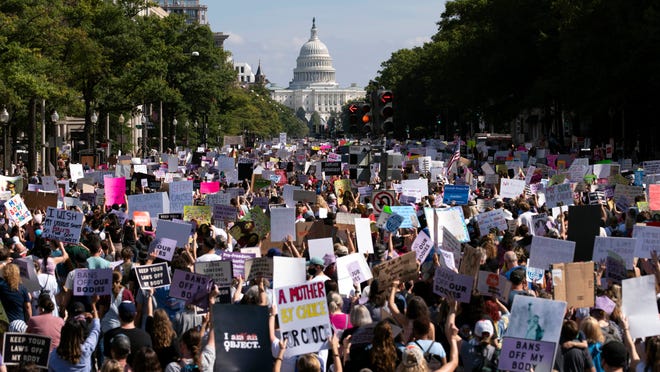
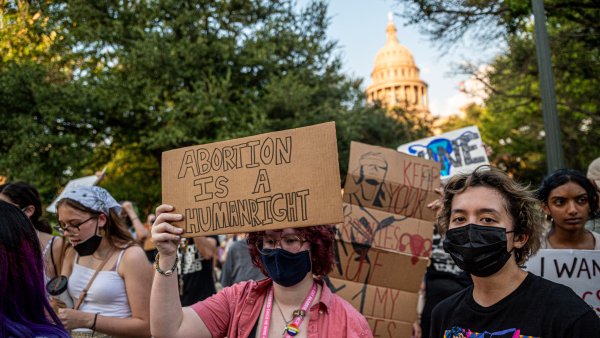
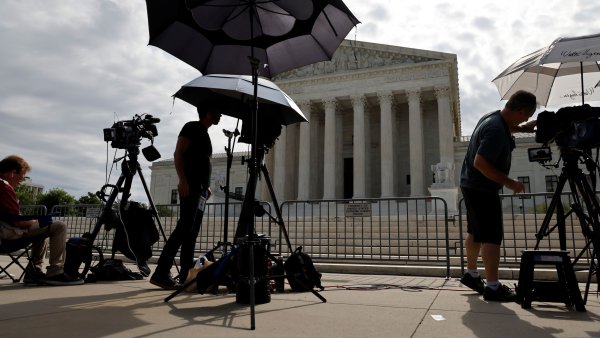

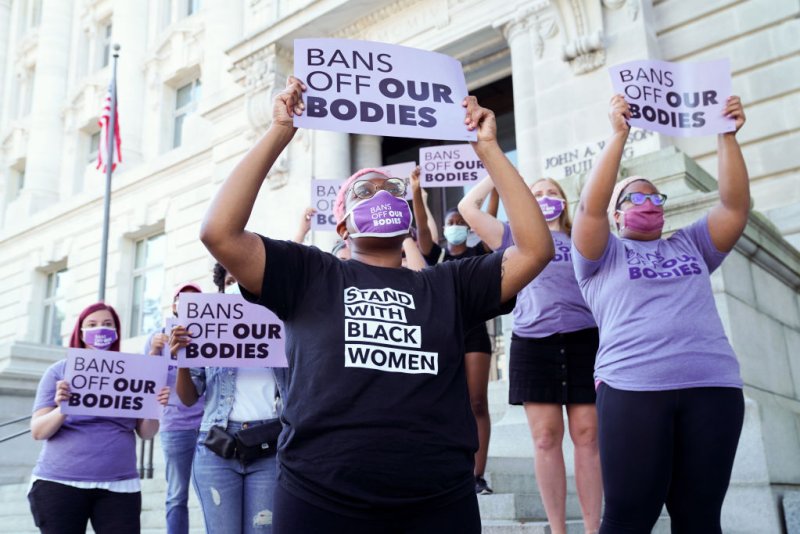
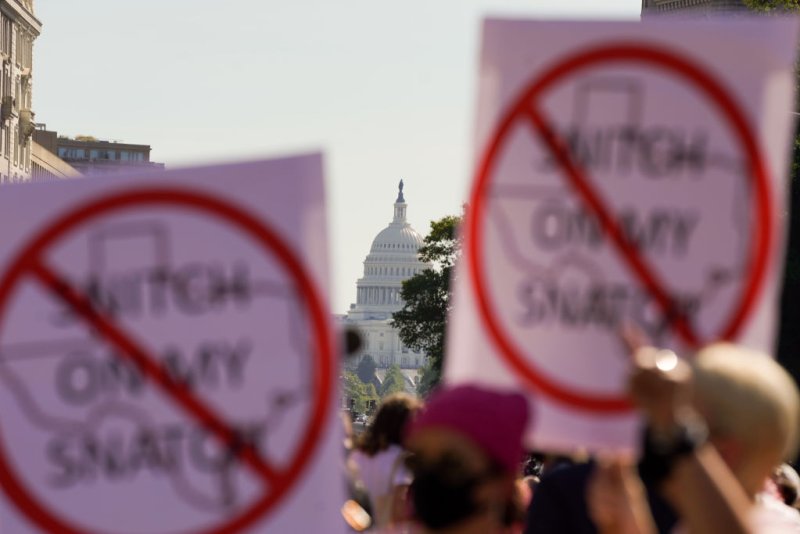


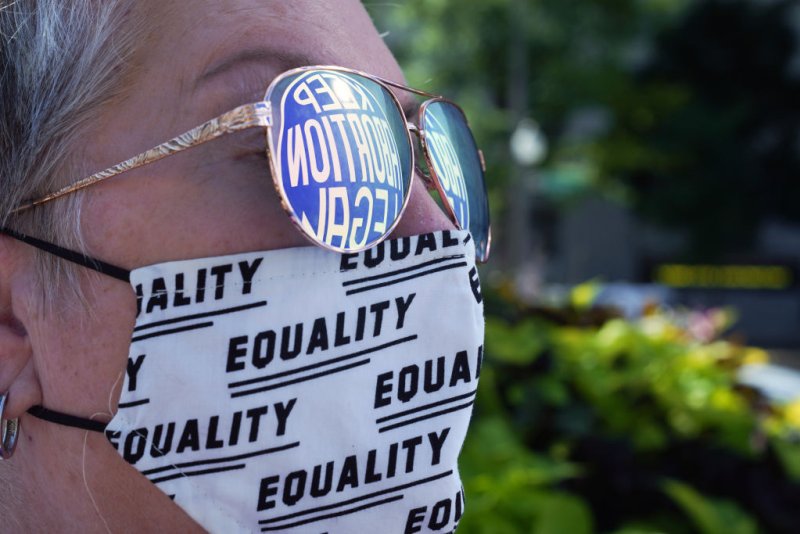

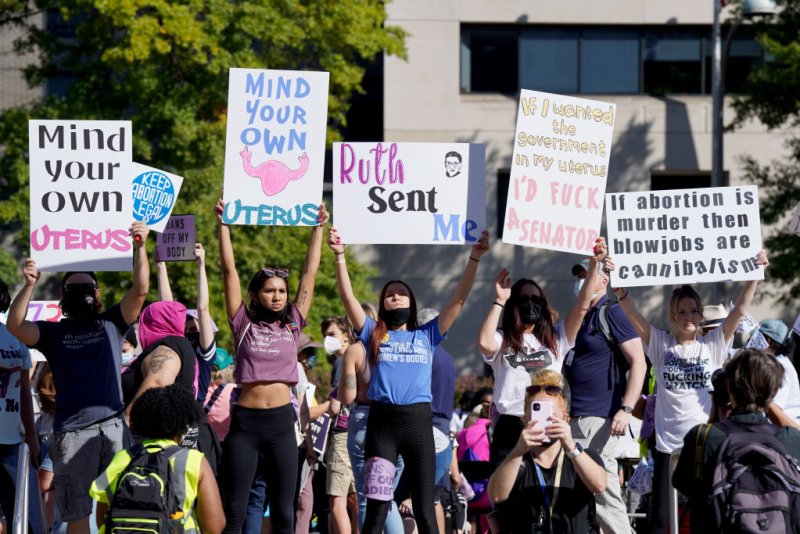
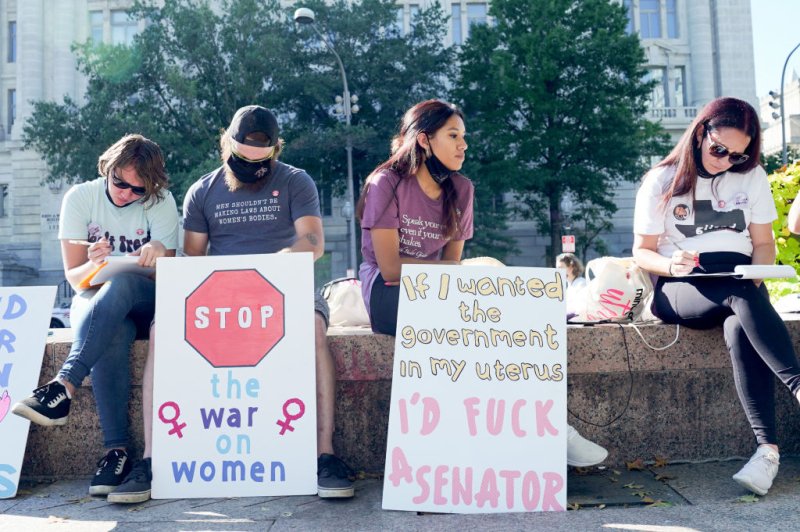
 Demonstrators gather at the Los Angeles Women’s March from Pershing Square to City Hall on Saturday, October 17, 2020. (Photo by Keith Birmingham, Pasadena Star-News/ SCNG)
Demonstrators gather at the Los Angeles Women’s March from Pershing Square to City Hall on Saturday, October 17, 2020. (Photo by Keith Birmingham, Pasadena Star-News/ SCNG)









